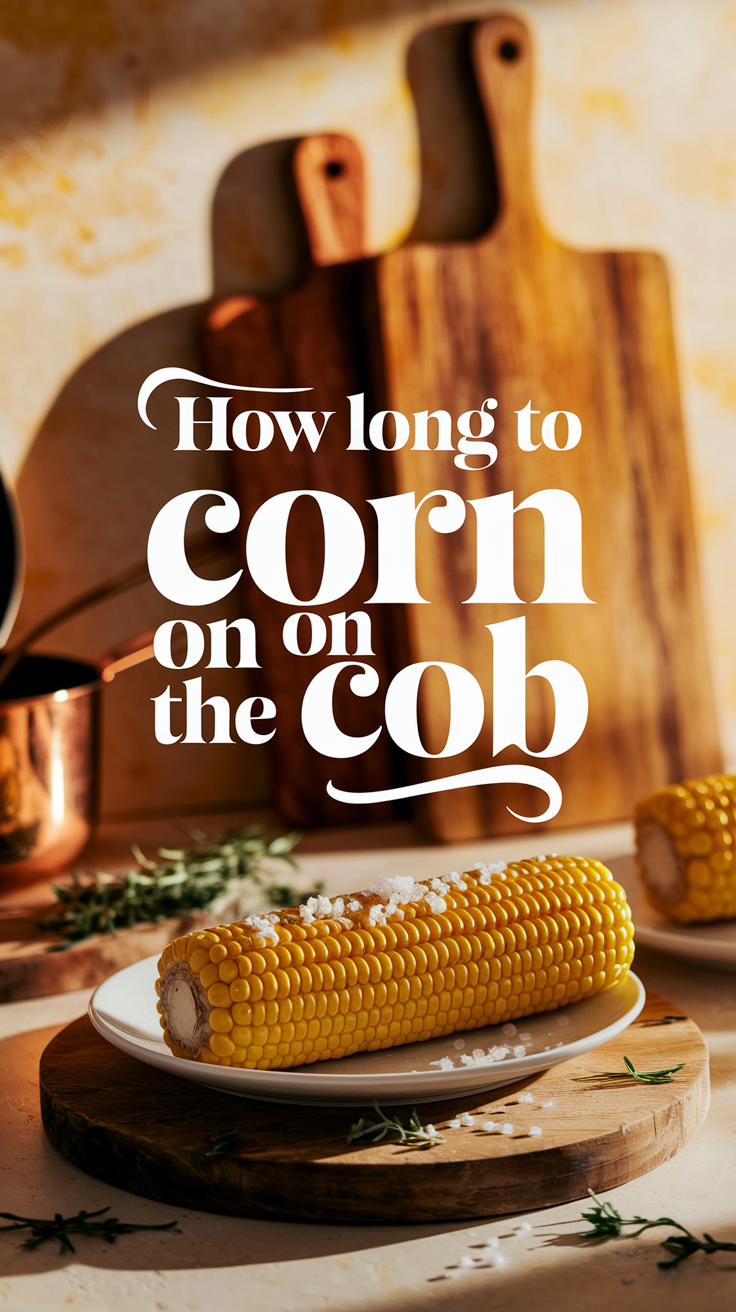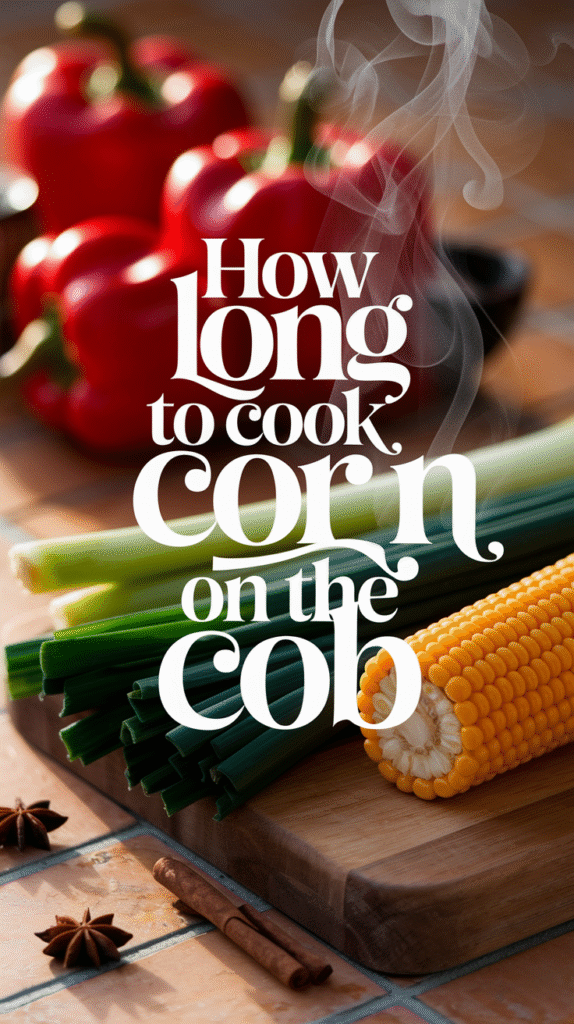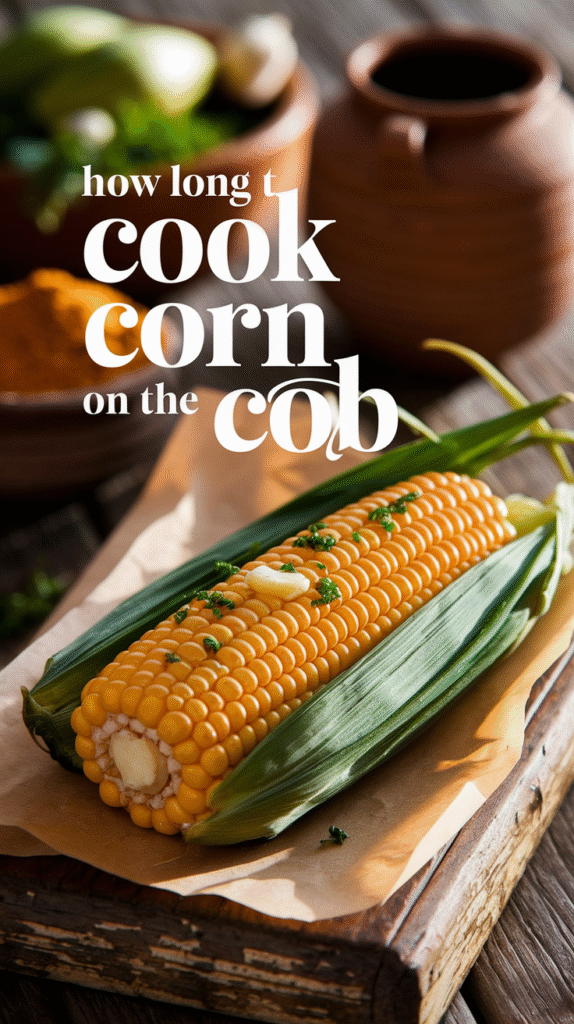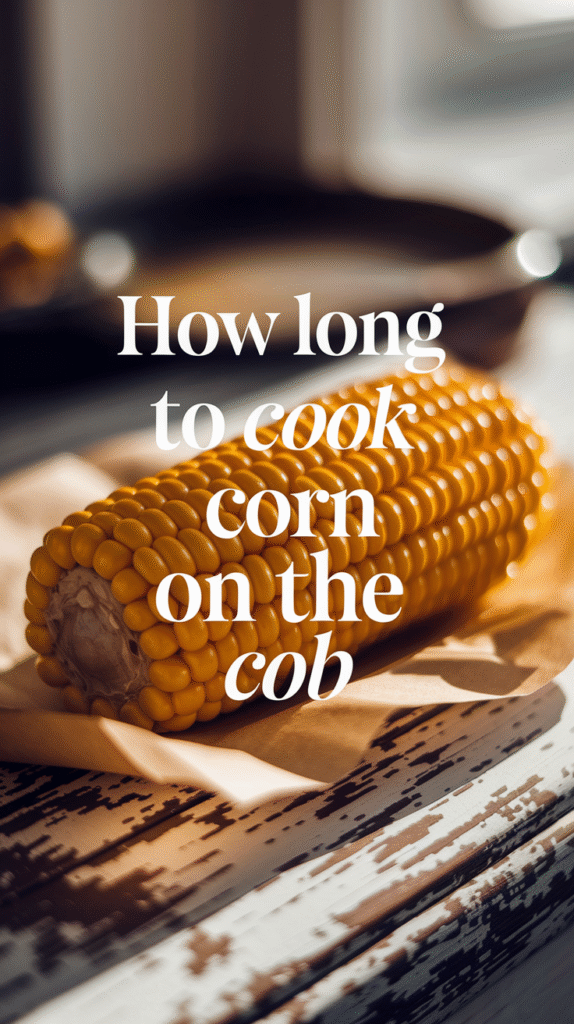Corn on the cob is a delicious and versatile side dish that pairs well with many meals. Whether you’re grilling, boiling, or roasting, knowing how long to cook corn on the cob is key to achieving that perfect tenderness and flavor. Below, you’ll find different methods for cooking corn on the cob, along with the timings for each technique.
Boiling Corn on the Cob
Boiling is one of the quickest methods to prepare corn on the cob. Follow these steps for great results:
- Fill a large pot with water, ensuring it’s enough to cover the corn entirely.
- Add a pinch of salt and bring the water to a boil.
- Carefully add the husked corn to the boiling water.
- Cover the pot and let it cook for 4 to 6 minutes.
- Once done, remove the corn and let it cool for a minute before serving.
Boiling corn is fast, making it a great option for busy weeknights. It is also easy to add seasonings or flavorings directly to the water, enhancing the corn’s natural sweetness.
Grilling Corn on the Cob
Grilling corn on the cob gives it a smoky flavor that’s hard to resist. Here’s how to do it:
- Preheat your grill to medium-high heat.
- Soak the corn in water (with the husks on) for about 30 minutes. This prevents the husks from burning while grilling.
- Place the corn directly on the grill, turning occasionally.
- Cook for 15 to 20 minutes until the kernels are tender and the husks are charred.
This method brings out the natural sugars in the corn, giving it a sweet and slightly charred taste. You can also brush the corn with melted butter before grilling for extra flavor.
Roasting Corn on the Cob in the Oven
Roasting corn is another excellent technique that brings out great flavors. To roast corn in the oven, follow these steps:
- Preheat your oven to 400°F (200°C).
- Wrap the corn (with husks on) in aluminum foil.
- Place the wrapped corn on a baking sheet and roast for 30 to 35 minutes.
Roasting corn this way will give it a sweet and rich taste. It’s perfect for a hands-off cooking approach while you prepare other dishes.
Microwaving Corn on the Cob
If you’re short on time, microwaving corn on the cob is a viable option. Here’s a simple way to do it:
- Place a husked ear of corn on a microwave-safe plate.
- Cover it with a damp paper towel.
- Microwave for about 3 to 5 minutes, depending on your microwave’s wattage.
Let it sit for a minute before carefully removing the paper towel. This method retains moisture and cooks the corn evenly, making it juicy and tender.
Steaming Corn on the Cob
Steaming will preserve more nutrients and natural sweetness. Here’s how to steam corn:
- Add 1 to 2 inches of water to a pot and bring it to a boil.
- Place a steamer basket above the boiling water.
- Add the husked corn to the basket, cover the pot, and steam for 6 to 8 minutes.
This method keeps the corn juicy and crunchy, making it a healthy cooking choice. It’s also great for maintaining the bright yellow color of the corn.
Helpful Tips
To further enhance your corn-on-the-cob experience, consider these tips:
- Always look for fresh corn with bright green husks. The kernels should be plump and milky.
- After cooking, try adding different toppings like melted butter, salt, or spices to elevate the flavor.
- Store any leftover corn in an airtight container in the fridge. Enjoy it within a few days for the best taste.
With these various techniques and timings, you can enjoy delicious corn on the cob any way you like. Experiment with the methods to find your favorite, whether it’s the quick boiling method or the flavorful grilling technique.
For more great cooking ideas and techniques, visit Love and Lemons and Food Network.
The Health Benefits of Eating Corn
Corn is not just a delicious addition to your meals; it also comes packed with numerous health benefits. This vibrant vegetable, enjoyed by many, is versatile and can be prepared in various ways. Let’s explore the remarkable advantages of incorporating corn into your diet.
Nutritional Profile of Corn
Corn is rich in essential nutrients, making it a valuable food source. Here’s a quick look at its nutritional composition per 100 grams:
| Nutrient | Amount |
|---|---|
| Calories | 86 |
| Carbohydrates | 19 g |
| Protein | 3 g |
| Fats | 1.2 g |
| Fiber | 2.4 g |
| Vitamins | B vitamins, Vitamin C |
| Minerals | Magnesium, Phosphorus, Potassium |
Heart Health
Including corn in your diet can support heart health. Corn contains fiber, which helps lower cholesterol levels. Lower cholesterol can lead to a reduced risk of heart diseases. Additionally, the antioxidants in corn, such as lutein and zeaxanthin, help in combating free radicals and inflammation, promoting overall cardiovascular health. For further reading, check out American Heart Association.
Weight Management
Looking to maintain a healthy weight? Corn is an excellent option because it is low in calories while being high in fiber. The fiber content can help you feel full longer, reducing the temptation for unhealthy snacks. Choosing corn as a side dish or snack can effectively aid in managing hunger and thereby support weight loss efforts.
Digestive Health
Eating corn regularly can contribute positively to your digestive system. The fiber in corn helps regulate bowel movements, which is essential for preventing constipation. Fiber also promotes healthy gut bacteria, supporting overall digestive health. If you’re interested in gut health, you can learn more at NCBI.
Source of Antioxidants
Corn is rich in various antioxidants, which can help fight against cell damage. Antioxidants like carotenoids present in corn are linked to reduced risks of chronic diseases, including some forms of cancer. By including corn in your meals, you enhance your body’s defenses against oxidative stress.
Vision Health
The carotenoids in corn, particularly lutein and zeaxanthin, are fantastic for your eye health. These substances help protect your eyes from harmful light and reduce the risk of age-related macular degeneration. corn into your diet can significantly contribute to maintaining healthy eyesight.
Skin Health
Vitamin C, found in corn, plays a crucial role in skin health. It helps in collagen production, which is essential for skin elasticity. Additionally, the antioxidants in corn can assist your skin in recovering from damage caused by the sun and pollution, giving you a more youthful appearance.
Versatility in Cooking
One of the great things about corn is its versatility. You can enjoy it in multiple forms, such as:
- Boiled or grilled corn on the cob
- Corn soup
- Sautéed corn with vegetables
- Corn salad
- Corn muffins or bread
This adaptability makes it easy to incorporate corn into your daily meals while enjoying its myriad health benefits.
Final Thoughts
If you want to explore the health benefits of corn further, consider adding it to your grocery list. Not only will you enjoy its delightful taste, but you will also be contributing to your overall well-being. For additional insights, visit Healthline to learn more about the nutritional value of corn and its numerous benefits.
Creative Toppings to Enhance Your Corn on the Cob
Corn on the cob is a beloved summer staple, cherished for its sweet flavor and satisfying crunch. While it’s delicious on its own, enhancing it with creative toppings can take your corn experience to the next level. Here are some delightful ideas to elevate your corn on the cob with an array of exciting flavors and textures.
Classic Combinations
Sometimes, sticking to the classics is the best approach. These timeless toppings can help you keep things simple yet delicious:
- Butter and Salt: A generous smear of melted butter sprinkled with sea salt never goes out of style.
- Parmesan Cheese: A sprinkle of freshly grated parmesan provides a savory kick.
- Lemon Zest: Add zest, and a squeeze of lemon juice for brightness.
Spicy Variations
If you like a bit of heat, these spicy toppings will ignite your taste buds:
- Chili Powder and Lime: Mix chili powder with a squeeze of lime for a zesty spice blend.
- Sriracha Mayo: Combine mayonnaise with sriracha for a creamy, spicy drizzle.
- Jalapeños: For those who enjoy a fiery flavor, chopped fresh jalapeños add a thrilling crunch.
Global Inspirations
Taking inspiration from around the world, these toppings reflect diverse culinary traditions:
- Mexican Street Corn (Elote): Slather corn with mayonnaise, sprinkle with crumbled feta or cotija cheese, chili powder, and fresh cilantro. Don’t forget a squeeze of lime!
- Indian-Style Corn: Coat with a mixture of melted butter, garam masala, and chopped fresh cilantro for an aromatic twist.
- Thai Peanut Sauce: Drizzle corn with creamy peanut sauce made with coconut milk, lime, and chili paste.
Sweet and Savory Blends
For those who enjoy a hint of sweetness, these toppings provide the perfect balance:
- Maple Syrup and Bacon: Drizzle maple syrup over the corn and top it with crispy bacon bits for a sweet and savory treat.
- Coconut Cream and Lime: Spread coconut cream on the corn and finish with a sprinkle of lime zest for a tropical touch.
- Honey and Cinnamon: A light drizzle of honey combined with a sprinkle of cinnamon creates a unique flavor profile.
Gourmet Twists
For a more sophisticated take, try these gourmet toppings to impress your guests:
- Truffle Oil: A few drops of truffle oil elevate the flavor of corn significantly, creating a luxurious dish.
- Crab and Tarragon: Top with fresh crab meat and a dab of tarragon aioli for a seafood-inspired delight.
- Blue Cheese and Balsamic Glaze: Crumbled blue cheese combined with a balsamic reduction adds depth and richness to each bite.
Simple Dipping Sauces
In addition to toppings, you might consider serving corn on the cob with delicious dipping sauces:
- Garlic Herb Butter: Mix softened butter with minced garlic and fresh herbs for a tasty dip.
- Avocado Dip: Creamy avocado mixed with lime juice and cilantro makes for a refreshing accompaniment.
- Ranch Dressing: This classic dressing can lend a creamy richness to your corn.
Whether you decide to stick with the traditional toppings or explore international flavors, there are endless possibilities for enhancing corn on the cob. Experimenting with various ingredients allows you to find combinations that you and your family will love. Serve your corn topped creatively at your next summer barbecue or picnic, and watch as your guests marvel at the delicious flavors.
For more ideas and inspiration, you can visit Food Network. Explore fun ways to enjoy your seasonal corn and make it a standout dish.
Common Mistakes When Cooking Corn and How to Avoid Them
Cooking corn on the cob can be a delightful experience, but many people make common mistakes that can affect its taste and texture. Here’s how to avoid these pitfalls and enjoy perfect corn every time.
Using Old Corn
One of the biggest mistakes when cooking corn is using old or stale corn. Corn starts to lose its sweetness soon after it’s picked. To ensure you are using fresh corn, look for bright green husks and plump kernels. You can easily check for freshness by peeling back a little of the husk and checking the kernels for a milky interior.
Not Removing the Silks
Another common error is failing to remove the silk thoroughly. The silky threads on corn can be stubborn and affect your cooking process. Always ensure you pull off the silk before cooking. If you want to make it easier, try removing the silk after soaking husked corn in water for about 30 minutes.
Overcooking the Corn
Overcooking can ruin any dish, and corn on the cob is no exception. Many people might think they need to boil corn for ages. However, corn typically only takes about 4-7 minutes to cook once the water is boiling. If you’re grilling, it might take around 10-15 minutes on a medium grill. Overcooking can result in tough kernels, so keep an eye on the clock.
Cooking without Salt
There’s a debate about when to add salt while cooking corn. Some people add it to the water, while others wait until after it’s cooked. Adding salt before cooking can toughen the corn. It’s generally best to add salt after cooking. This will preserve the sweet flavor and keep the kernels tender.
Cooking in Unfiltered Water
Using unfiltered water can impact the taste of your corn. Tap water can have minerals and chemicals that alter the flavor. If possible, use filtered or spring water for boiling your corn. Your corn will taste fresher and more natural.
Not Fully Embracing the Versatility
Corn can be used in various dishes beyond just boiling. Experimenting with different cooking methods can enhance your culinary experience. Try grilling, roasting, or even making corn salsa. Each method brings out distinct flavors and makes corn a versatile ingredient in your meals.
Cooking Methods Overview
| Method | Cooking Time | Flavor Notes |
|---|---|---|
| Boiling | 4-7 minutes | Sweet and tender |
| Grilling | 10-15 minutes | Smoky and charred |
| Roasting | 20-25 minutes | Caramelized and sweet |
Ignoring Seasoning
Many people think corn on the cob needs no seasoning, but that’s not true. Adding butter, salt, and other seasonings can elevate the simple flavor of corn. Try using flavored butters or spices like paprika, chili powder, or even fresh herbs to complement the sweetness of the corn.
Not Storing Corn Properly
Storing corn the wrong way can also impact its flavor and sweetness. Always store your corn in the refrigerator if you’re not cooking it right away. Ideally, cook it on the same day you purchase it, as fresh corn tastes best. Keep it in a paper bag or a breathable container to prevent moisture, which can lead to spoilage.
To delve deeper into the culinary magic of corn, check out resources like the National Corn Growers Association for more tips and recipes. Enjoy experimenting with your corn on the cob, and savor every bite!
Comparing Cooking Methods: Boiling, Grilling, and Microwaving Corn on the Cob
When it comes to enjoying flavorful and sweet corn on the cob, there are multiple cooking methods to choose from, each with its unique benefits and flavor. Boiling, grilling, and microwaving are three common techniques that will give you distinct results. Here’s a comparison of these methods to help you decide how long to cook corn on the cob using each approach.
Boiling Corn on the Cob
Boiling is one of the most traditional methods for cooking corn on the cob. It’s straightforward and ensures the kernels are tender and sweet. Here’s how to do it:
- Fill a large pot with water and bring it to a rolling boil.
- Add a pinch of salt (optional) and place the shucked corn in the boiling water.
- Cover the pot and start a timer.
Cooking times for boiling corn on the cob can vary, but generally:
- Fresh corn: 4 to 6 minutes
- Frozen corn: 6 to 8 minutes
After the timer goes off, quickly remove the corn and run it under cold water for a moment to stop the cooking process. This way, you maintain that perfect crunch!
Grilling Corn on the Cob
Grilling adds a wonderful smoky flavor to corn, making it particularly enjoyable during summer barbecues. Here’s a simple guide for grilling corn:
- Preheat your grill to medium-high heat.
- Husk the corn and remove all the silk. You can also soak the cobs in water for about 30 minutes to help keep them moist.
- Place the corn directly on the grill or use aluminum foil to keep the kernels from getting charred.
For the best results, grill corn for:
- Without foil: 10 to 15 minutes, turning every few minutes
- With foil: 15 to 20 minutes
Don’t forget to brush the corn with butter and sprinkle salt before serving for an extra touch of flavor!
Microwaving Corn on the Cob
If you’re short on time, microwaving corn on the cob is an incredibly quick and convenient option. This method locks in moisture and flavor while cooking. Follow these steps:
- Place the shucked corn on a microwave-safe plate.
- Cover it with a damp paper towel.
- Microwave on high.
Cooking times when microwaving will depend on whether the corn is fresh or frozen:
- Fresh corn: 4 to 6 minutes
- Frozen corn: 6 to 8 minutes
Be careful when removing the corn as it will be hot. Let it cool for a minute before digging in!
Comparative Table of Cooking Times
| Method | Fresh Corn | Frozen Corn |
|---|---|---|
| Boiling | 4 to 6 minutes | 6 to 8 minutes |
| Grilling | 10 to 15 minutes | 15 to 20 minutes |
| Microwaving | 4 to 6 minutes | 6 to 8 minutes |
Each method offers an enjoyable way to prepare corn on the cob. Boiling is the quickest and simplest, while grilling adds a smoky taste, perfect for outdoor meals. Microwaving is a time-saver, making it ideal for busy weekday dinners. Whichever method you choose, you’re sure to delight in the sweetness of fresh corn!
For more tips and techniques on how to cook corn on the cob and other delicious recipes, check out Food Network and Serious Eats.
Conclusion
Cooking corn on the cob can be a delightful experience and a tasty addition to your meals. By understanding the different cooking techniques—be it boiling, grilling, or microwaving—you can choose the method that best fits your taste and time constraints. Remember, timing is crucial; overcooking can lead to a less satisfying texture, while undercooking might not bring out the sweet flavors of the corn. With the right techniques, you’ll ensure perfectly cooked corn every time.
In addition to being delicious, corn is packed with health benefits. It contains fiber, vitamins, and antioxidants that contribute to your overall wellness. Enjoying corn on the cob can be a simple and nutritious way to enhance your diet without compromising on taste.
To make your corn experience even more enjoyable, consider experimenting with creative toppings. Whether you prefer classic butter and salt or adventurous flavors like chili lime or parmesan, there’s a topping for everyone. These enhancements can elevate the dish to new culinary heights and impress your guests.
However, many people fall into common pitfalls when cooking corn. Avoiding these mistakes, such as cooking with husks on or not properly seasoning, can significantly enhance your results. Being mindful of these factors will help you serve corn that is flavorful and inviting.
Next time you’re preparing corn on the cob, keep these insights in mind. With the right cooking techniques, health benefits, creative enhancements, and an awareness of common mistakes, you’ll be well on your way to mastering this summer classic. Enjoy your corn on the cob and savor each delicious bite!







Leave a Reply